Mastering the Art of Steak Cooking on a Frying Pan
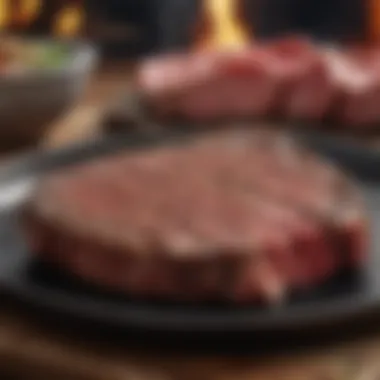
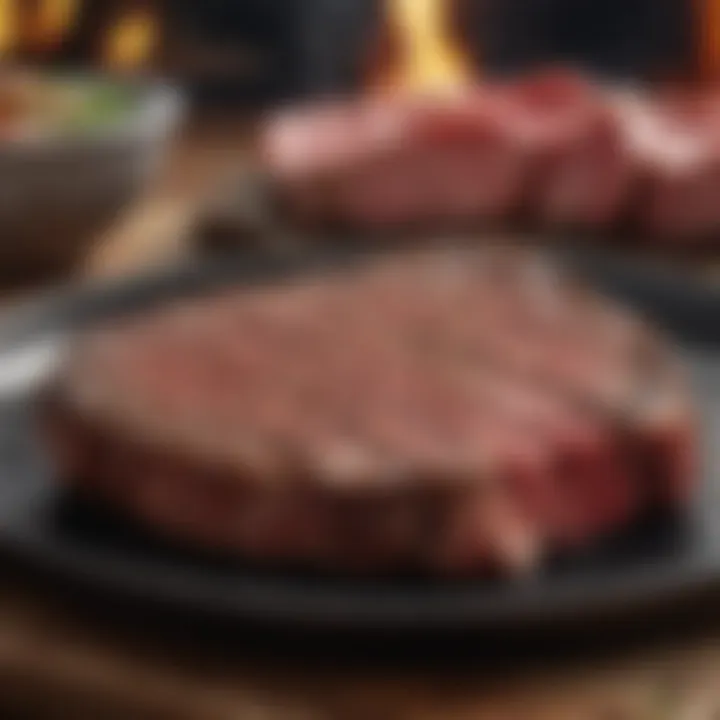
Intro
Cooking steak on a frying pan is an art form that combines techniques, timing, and a deep understanding of the protein itself. This article will delve into the essentials of achieving a perfectly cooked steak that is both flavorful and tender. We aim to provide insights not only into choosing the right cut of meat but also into the preparation and cooking methods that yield the best results. The focus throughout will be on practical tips that readers can apply easily in their kitchens.
Key Benefits
Understanding the benefits of cooking steak on a frying pan can enhance one's culinary adventures.
- Physical Health Benefits
Steak is a rich source of high-quality protein, essential for muscle repair and growth. It also contains important nutrients like iron, zinc, and B vitamins that contribute to overall health. Consuming a well-cooked steak can support energy levels and improve vitamin intake. Furthermore, when cooked properly, steak can be part of a balanced diet that includes vegetables and whole grains, optimizing nutrient absorption. - Mental Well-being Enhancements
The process of cooking steak can be therapeutic. Engaging with food preparation can improve mood and reduce stress levels. Savoring a well-cooked steak promotes mindfulness by encouraging individuals to appreciate flavors and textures, thereby enhancing the dining experience.
"Cooking is an act of love, and a perfectly cooked steak is a testament to that passion."
Selecting the Right Cut
Choosing the right cut of beef is critical for achieving the best flavor and tenderness. Cuts such as ribeye, filet mignon, and New York strip are commonly chosen for frying due to their marbling and tenderness. Each cut has unique characteristics:
- Ribeye: Rich in flavor thanks to its fat content. Best for those who enjoy a juicy steak.
- Filet Mignon: The most tender cut, ideal for individuals looking for a buttery texture.
- New York Strip: Balanced fat and flavor, suitable for various tastes.
By selecting the right cut, one can significantly impact the final flavor of the steak.
Preparing the Steak
Preparation is a vital step in the cooking process. Start by bringing the steak to room temperature. This ensures uniform cooking. Season simply with sea salt and black pepper to enhance the natural flavors of the meat. Additionally, patting the steak dry with paper towels removes excess moisture, which aids in achieving a nice sear on the frying pan.
Cooking Techniques
When it comes to frying steak, the method you use matters. Here are some effective techniques:
- Searing: Heat a frying pan over high heat, adding a small amount of oil after it's hot. Place the steak in the pan and resist the urge to move it around. Allowing it to sear creates a flavorful crust.
- Basting: For added flavor, consider basting the steak with butter and aromatics like garlic or thyme during the last few minutes of cooking.
Achieving optimal doneness requires attentiveness. Using a meat thermometer can help gauge internal temperature accurately.
Epilogue
Mastering the skills involved in cooking steak on a frying pan can elevate any home cook’s repertoire. It not only provides physical nourishment but also enriches the culinary experience with mindfulness and appreciation for the art of cooking. Understanding the meat selection, preparation, and cooking techniques lays the groundwork for a satisfying and flavorful meal.
Prologue to Cooking Steak
Cooking steak is both an art and a science. Having a good grasp of steak preparation can elevate an ordinary meal into an exceptional one. The nuances involved in choosing the correct cut of meat, understanding its characteristics, and applying the right cooking techniques are vital steps. For those serious about their culinary skills, knowing how to cook steak can lead to a deeper appreciation of flavors and textures.
In this article, we will examine crucial aspects that go beyond mere cooking. This guide provides insights for home cooks who wish to master the frying pan method of cooking steak, focusing on details that can make a significant difference. Understanding how to prepare steak properly can save time and potential mistakes while enhancing the overall dining experience.
Understanding Steak Cuts
Common Cuts of Steak
Common cuts of steak include ribeye, sirloin, filet mignon, and flank. Each cut has its unique traits and flavors. For instance, ribeye is known for its high fat content, which contributes to a rich flavor. Sirloin, on the other hand, is leaner and often more affordable, making it popular among home cooks. These characteristics guide selections based on personal preferences, dietary needs, and cooking methods.
Benefits of Common Cuts:
- Flavor: Cuts like ribeye deliver robust flavor due to marbling.
- Versatility: Different cuts can be used for various recipes, from grilling to pan-searing.
Unique Features:
The ribeye's marbling ensures juiciness, while filet mignon's tenderness presents a melt-in-your-mouth experience. However, these cuts can vary in price, potentially impacting the choice for budget-conscious individuals.
Choosing Quality Meat
Selecting quality meat is essential for a successful steak dish. Factors such as grade, color, and texture matter. Higher grades, such as USDA Prime, usually offer better flavor due to more marbling.
Key Characteristics:
- Texture: Quality meat should feel firm and have a consistent grain.
Benefits:
Opting for higher quality meat can lead to enhanced flavor and tenderness, as lower quality cuts might result in a tougher eating experience.
Characteristics of Each Cut
Each cut of steak comes with distinct characteristics. Ribeye is known for its rich taste, while filet mignon is prized for being exceptionally tender. Understanding these traits can help cooks anticipate the resulting dishes.
Benefits of Recognizing Characteristics:
- Flavor Profile: Different cuts work well with various seasonings and cooking methods.
Unique Features:
For example, flank steak is heavier in fiber, meaning it may require marination for optimal tenderness, while filet mignon needs minimal seasoning to let its natural flavor shine. Knowing this can influence preparation choices.
In summary, mastering the introduction to cooking steak begins with understanding its cuts, choosing quality meat, and recognizing the unique features of each option. This knowledge lays the foundation for better preparation and cooking practices.
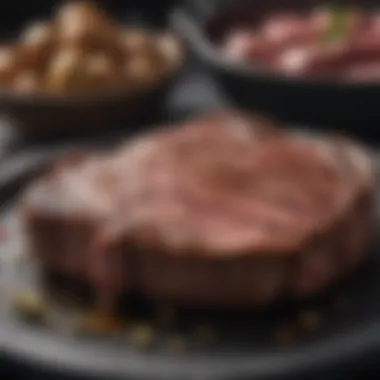
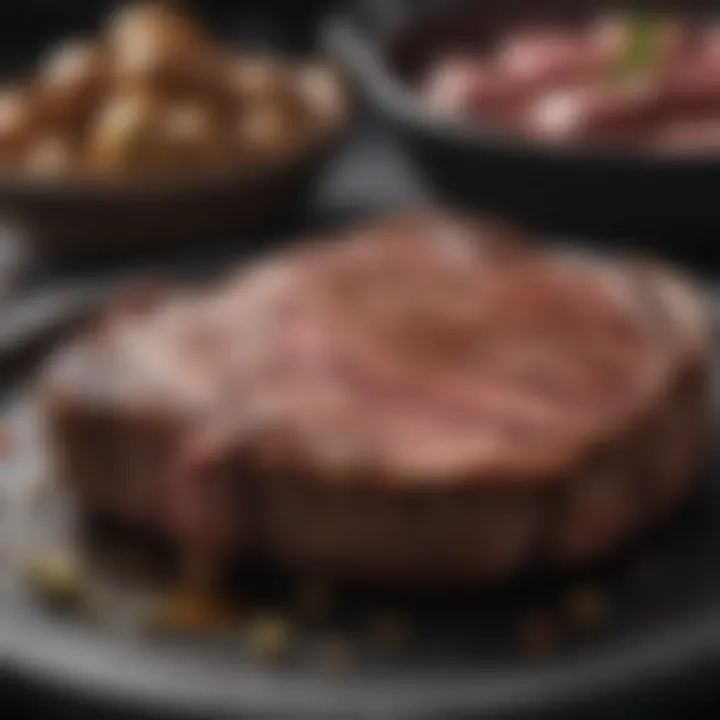
Essential Cooking Tools
Cooking steak properly requires appropriate tools that make the process efficient and effective. Selecting the right equipment not only contributes to achieving the desired flavor but also ensures safety and ease when preparing the meal. Each tool plays a specific role, making it vital to understand their importance and functionality.
Frying Pan Varieties
When it comes to frying steak, the type of frying pan used is essential. Different materials and designs influence heat distribution, cooking speed, and the final texture of your steak. Here, we will explore three popular frying pan options: Non-stick Frying Pans, Cast Iron Skillets, and Stainless Steel Options.
Non-stick Frying Pans
Non-stick frying pans are widely used for cooking steak due to their smooth surface. This feature aids in preventing the steak from sticking, making the cooking process simpler. The benefit of using a non-stick frying pan lies in its ability to facilitate easy flipping and removing of the steak without losing any parts of it. However, one should be careful regarding the heat level since high temperatures can damage the non-stick coating, altering the pan's effectiveness over time. For cooking steak, non-stick pans may require a bit more oil compared to other frying methods.
Cast Iron Skillets
Cast iron skillets are renowned for their ability to retain and evenly distribute heat. This characteristic is especially beneficial when searing steak, as it allows for a consistent cooking temperature across the surface of the meat. Additionally, a well-seasoned cast iron skillet can create a beautiful crust on the steak, enhancing flavor and texture. However, cast iron skillets can be heavy, making them a bit cumbersome to handle. Furthermore, they require specific care to maintain their seasoning and prevent rust, which can deter some home cooks from using them.
Stainless Steel Options
Stainless steel frying pans are favored for their durability and heat retention. They are excellent for achieving a good sear on steak, which is crucial for developing rich flavors. One key characteristic of stainless steel pans is their ability to withstand high heat, making them suitable for techniques like browning and deglazing. However, steaks are more likely to stick to stainless steel compared to non-stick options, so proper techniques must be employed, such as ensuring adequate preheating and using sufficient cooking oil.
Additional Equipment
Besides the frying pan, certain additional tools enhance the steak cooking experience.
Meat Thermometer
A meat thermometer offers essential assistance in ensuring your steak reaches the desired level of doneness. It eliminates the guesswork, allowing one to cook the meat accurately. The key characteristic of a good meat thermometer is its ability to provide quick and accurate readings of internal temperature. After cooking, the steak will maintain its optimal flavor and texture when cooked to the proper temperature. Some models come with instant-read features, while others may need some time for precision.
Spatula or Tongs
Using appropriate utensils, such as spatulas or tongs, is vital for turning the steak during cooking. This necessity arises because the right tool protects the meat from tearing or sticking to the frying pan. Tongs are particularly beneficial as they offer a solid grip, allowing easy maneuvering. Spatulas can be useful for a gentle lift if the steak is already well-cooked and can easily break apart.
Oven Mitts
Oven mitts are an essential safety measure in the kitchen while cooking steak. Since frying pans can get very hot, having good quality oven mitts prevents burns or accidents. The best oven mitts are made of heat-resistant materials, providing a strong grip and protection. A proper fit is important, as overly tight or loose mitts can defeat their purpose, potentially leading to spills or dropped cookware.
Preparing the Steak
Preparing the steak is a crucial step in achieving the best possible result when cooking with a frying pan. This stage plays a significant role in flavor development and texture enhancement. Proper preparation not only ensures a tasty end product, but also helps to maintain the natural qualities of the meat. Key aspects include thawing, marinating, and seasoning, each contributing distinct benefits.
Whenever you handle the meat, consideration should be given to how preparation affects the overall cooking process. Time taken in this section will impact your meal's quality significantly. This is especially vital for those wanting high-quality results consistently. Understanding and executing preparation techniques can set the foundation for a successful steak cooking experience.
Thawing and Marinating
Thawing Techniques
Thawing is the first step and critical for achieving even cooking throughout your steak. The most common and effective method is to place the steak in the refrigerator for several hours or overnight. This method allows meat to come to a safe, uniform temperature gradually. Alternatively, you could opt for a cold water bath. Place the steak in a sealed plastic bag and submerge it in cold water for about an hour. The key characteristic of these approaches is that they prevent the meat from reaching temperatures where harmful bacteria can grow.
Using these techniques before cooking is beneficial, as it forms a base for proper marinating and seasoning later. One disadvantage might be the time required for refrigerator thawing, which does not offer a quick solution.
Basic Marinades
Marinades serve to enhance flavor and tenderize the meat. A basic marinade typically consists of an acid, such as vinegar or citrus juice, combined with oil and seasoning. The acid helps break down muscle fibers, making the steak more tender. This characteristic of marinades is especially beneficial when dealing with tougher cuts.
Simple ingredients can lead to exceptional flavors. However, the choice of marinade must align with the specific cut of meat and the cook's goals. One downside is the potential for strong flavors overwhelming the meat itself when using too much marinade.
Timing for Marinades
The timing of marinating is just as important as the marinade itself. Generally, a cut of steak should marinate for at least 30 minutes to a few hours. For tougher cuts, extending up to overnight can yield better results. This characteristic of timing highlights how enhanced tenderness and flavor can be achieved through careful waiting.
A consideration is that marinating too long can result in a mushy texture. Balancing the time spent is essential to maintain desirable firmness in the meat.
Seasoning Your Steak
Types of Seasoning
Seasoning is an essential aspect that influences the final taste of your steak. Various seasoning options exist, including rubs and simple salt and pepper mixtures. Each type provides a unique flavor profile that can transform a simple steak into an impressive dish. This characteristic makes seasoning a very beneficial part of the overall cooking process, as it allows for creativity.
A unique feature of using a mix of spices is the ability to tailor the flavor to individual preferences. However, over-seasoning can overshadow the natural flavors of the meat, potentially altering the intended result.
Timing for Seasoning
When it comes to seasoning, timing matters. Seasoning your steak too early can draw out moisture, leading to a dry end product. The best practice is to season just before cooking. This characteristic ensures that flavors absorb into the surface without compromising the meat.
Additionally, a timely application helps in developing a flavorful crust during the cooking process. On the downside, waiting too long can cause reduced flavor absorption, yielding a less impactful steak.
Salt and Pepper Basics
Salt and pepper form the foundation of steak seasoning. The basic essence of this combination enhances taste without masking the meat's natural flavors. Salt helps to draw moisture, while pepper adds a subtle kick. This foundational approach to seasoning is especially popular due to its simplicity and effectiveness.
A unique advantage of focusing on these staples is that they are easily accessible and complement most steak cuts. However, relying solely on this basic mix might limit potential flavor exploration.
"Preparing your steak well sets the stage for achieving the perfect cooking experience. Understand each step and its impact will guide you towards culinary success."
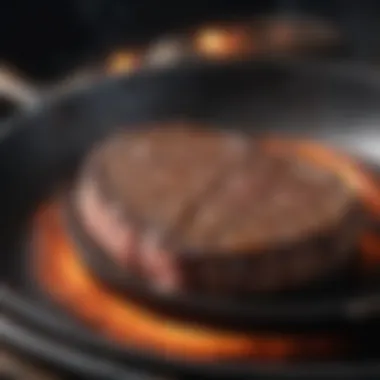
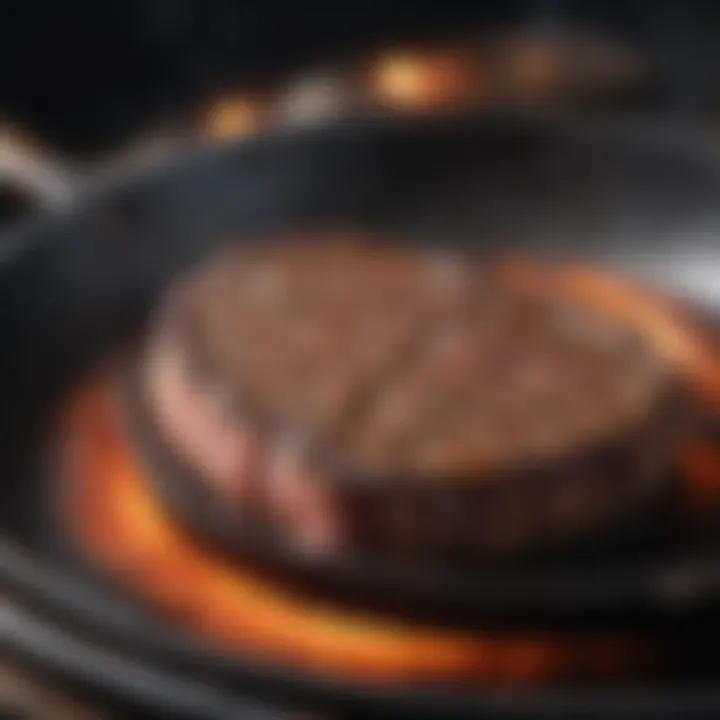
Cooking Techniques
Understanding the cooking techniques is vital for mastering steak cooking in a frying pan. Each method has its own nuances that affect the final result in texture and flavor. Proper techniques help ensure that the steak is not only cooked to the desired doneness but also retains moisture and enhances its natural flavors. By paying attention to these techniques, one can achieve a perfectly seared steak that is juicy and flavorful.
Preheating the Frying Pan
Importance of Preheating
Preheating the frying pan is a crucial step in steak cooking. It sets the stage for even cooking and optimal searing. A hot pan allows the meat to form a crust quickly, which helps seal in juices and flavor. This characteristic prevents the steak from becoming dry during the cooking process, which is a common outcome when starting with a cold pan. Preheating is beneficial for those aiming to achieve a professional-quality steak at home.
How to Effectively Preheat
To effectively preheat a frying pan, one should start by selecting a medium to high heat setting. Allow the pan to heat for several minutes, checking occasionally to gauge readiness. An effective preheating method contributes significantly to the cooking process by ensuring that the heat is evenly distributed. A unique feature of this technique is that it maximizes flavor and texture right from the start. However, care should be taken not to overheat the pan, as it can lead to burning.
Identifying the Right Heat Level
Identifying the right heat level is essential for successful steak cooking. Too high a heat can easily burn the exterior, while too low can lead to prolonged cooking, drying out the meat. A beneficial approach is to conduct a simple water test: sprinkle a few drops of water on the pan. If they sizzle and evaporate quickly, the pan is at the right temperature. This technique helps ensure the meat cooks evenly and maintains its moisture content, enhancing overall flavor and tenderness.
The Art of Searing
Timing for the Perfect Sear
Timing is a key element in searing steak correctly. It is essential to allow enough time for the crust to develop without overcooking the interior. The ideal sear typically requires around two to three minutes per side for a medium-thick cut of steak. This timing maximizes the Maillard reaction, which is responsible for the flavorful crust. A careful balance allows the interior to remain tender, making it a crucial consideration in steak cooking.
Visual Cues for Searing
Visual cues play an important role in searing steak. Observing the color and texture can guide one toward achieving the desired sear. A good sear exhibits a deep brown color and a slight crust. When the steak naturally lifts away from the pan with minimal sticking, it indicates a sufficient crust has formed. This characteristic helps in knowing when to flip the steak, minimizing the risk of over or undercooking.
Dealing with Smoke
Dealing with smoke is an inevitable part of cooking steak. A steady release of smoke is a sign that the pan is hot enough, but excessive smoke indicates that something might be burning. Good ventilation is essential to handle this challenge. Using a splatter guard can also minimize mess and maintain visibility. The unique aspect of managing smoke effectively is ensuring an enjoyable cooking environment while achieving a well-cooked steak.
Cooking Times for Different Cuts
Time Guidelines for Steak Thickness
Cooking times and steak thickness are closely related. Thicker cuts naturally require longer cooking times compared to thinner ones. A general guideline is to cook thinner cuts for 3-4 minutes per side, while thicker cuts may need 6-8 minutes. Following these time guidelines helps ensure the meat achieves the desired doneness without becoming tough. It is important to adjust cooking times based on personal preference and cut variety.
Using a Meat Thermometer
Using a meat thermometer can enhance precision in steak cooking. This tool allows for an accurate measurement of the internal temperature, reducing the guesswork in determining doneness. For instance, a medium-rare steak typically reaches an internal temperature of around 130-135°F. The unique feature of a thermometer is its ability to take the uncertainty out of the process, ensuring consistent quality every time
Resting Period Post-Cooking
Resting the steak after cooking is a crucial step that should not be overlooked. Resting allows juices to redistribute throughout the meat, enhancing flavor and tenderness. Generally, a resting period of five to ten minutes is adequate, depending on the size of the steak. Covering it with foil during resting retains warmth without causing overcooking. This characteristic makes resting a beneficial practice for achieving a more succulent final product.
Finishing Touches
Finishing touches are crucial when cooking steak on a frying pan. They transform a good meal into a great one. These final steps focus on checking doneness and allowing the steak to rest. Skipping these can lead to undesirable results, such as dry meat or unattractive presentation.
Checking for Doneness
Assessing doneness ensures the steak is cooked to the preferred level. This process includes checking the internal temperature, visual cues, and acknowledging individual preferences.
Internal Temperature Ranges
Understanding internal temperature ranges is fundamental in steak preparation. Generally, the ideal internal temperatures are:
- Rare: 120-125°F (49-52°C)
- Medium Rare: 130-135°F (54-57°C)
- Medium: 140-145°F (60-63°C)
- Medium Well: 150-155°F (65-68°C)
- Well Done: 160°F (71°C) and above.
These ranges are popular as they help achieve the desired texture and juiciness. By knowing the correct temperatures, you can avoid overcooking, which greatly affects flavor. The big benefit here is that meat cooked to the right temperature retains moisture, making the steak tender and flavorful.
Visual Indicators for Doneness
Using visual indicators is another reliable method for determining doneness. Factors such as color, the firmness of the meat, and juices all provide valuable information.
- Color:
- Firmness: Lightly pressing the steak can help gauge its doneness.
The primary advantage of using visual cues is that they do not require tools, making the cooking process seamless. However, they require practice to interpret accurately.
- Rare: bright red center;
- Medium Rare: warm red center;
- Medium: pink center;
- Medium Well: slightly pink center;
- Well Done: little to no pink.
Personal Preference and Variances
Personal preferences vary widely among individuals. While some prefer their steak rare, others may opt for well done. This aspect significantly contributes to the overall enjoyment of the meal. Individual tastes create variety; therefore, understanding them helps cater to guests’ preferences. The key characteristic is that personal preference allows for adaptability in cooking methods. It may pose a challenge during gatherings, as not everyone shares the same taste. Proper communication can solve this issue, ensuring everyone gets their steak cooked according to their desires.
Resting the Steak
Resting is another essential part of the cooking process that should not be overlooked. After cooking, letting the steak sit is important for flavor and texture enhancement. This step allows the juices to redistribute, preventing them from escaping when cut.
Why Resting Matters
Resting matters because it significantly impacts the overall quality of the steak. As heat rises, the pressure inside the meat causes juices to flow toward the center. If cut immediately, these juices escape, resulting in a dryer product. The unique feature of resting is that it enhances juiciness, adding to the flavor profile. It also contributes to achieving a desirable texture; a well-rested steak is generally more tender to bite into.
Optimal Resting Times
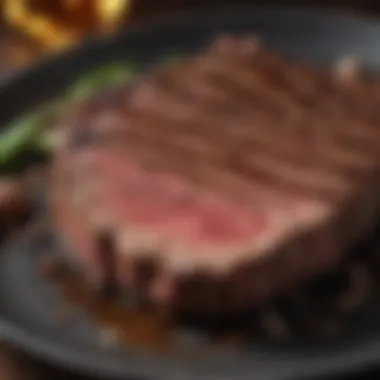
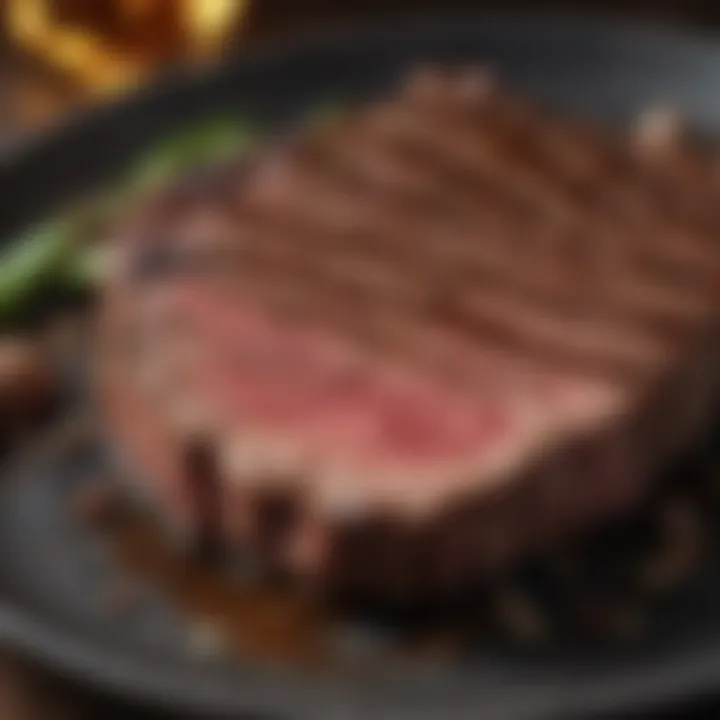
Optimal resting times for steak vary based on the thickness and size of the cut. A general guideline is to rest the steak for about five to ten minutes. Thicker cuts may benefit from even longer resting periods. This characteristic is beneficial since it allows the steak to reach ideal internal temperature while maintaining warmth. A downside is that it might require additional patience in a busy kitchen, since it could make guests wait longer.
How to Cover While Resting
Covering the steak while resting helps retain heat. Using aluminum foil is common, as it prevents air exposure while allowing steam to escape. Covering keeps the steak warm without cooking it further, allowing even internal temperatures. The main advantage is that it ensures the steak stays warm for serving. However, covering too tightly can create steam, potentially affecting the crust.
Using a loose cover is preferable to balance retaining heat and maintaining texture.
Always remember that finishing touches are pivotal in enhancing the taste and presentation of steak cooked in a frying pan.
Common Mistakes to Avoid
Understanding and recognizing common mistakes when cooking steak on a frying pan is crucial. Avoiding these errors significantly enhances both the flavor and texture of the meat. This section reviews some frequent blunders, like overcooking and inadequate seasoning, which can detract from an otherwise well-prepared steak. By knowing these pitfalls, you can elevate your cooking skills and ensure that your steak is enjoyable.
Overcooking
The Impact of Overcooking
Overcooking is a critical mistake many cooks make. When steak is overcooked, it becomes tough and dry. This is because the muscle fibers contract excessively and moisture evaporates. A well-cooked steak should retain juices and be tender to the bite. The key aspect of avoiding overcooking is paying attention to cooking time and temperature. This article emphasizes the importance of using a meat thermometer to check internal temperatures. Overcooked steak lacks appeal and can be a poor choice for both casual dinners and special occasions.
Recognizing Signs
Recognizing the signs of overcooking is fundamental for success. A steak that is well-cooked should have a nice sear and a juicy interior. Look for visual indicators such as excessive charring or a dry surface. The texture of the steak can also give clues; it should feel firm but spring back slightly when pressed. This article discusses these signs in detail, helping you identify when your steak is in danger of becoming overdone. A thorough understanding of these indicators is valuable.
How to Avoid It
To avoid overcooking, one effective strategy is to cook the steak at a moderate heat. This allows for even cooking without excessive charring on the outside. Another technique includes using a timer to ensure you do not exceed recommended cooking times. This article suggests flipping the steak only once, allowing each side ample time to develop a crust while preserving moisture. A consistent approach will build your confidence in achieving the perfect doneness.
Inadequate Seasoning
Why Seasoning is Key
Inadequate seasoning can lead to a bland steak, failing to highlight its natural flavors. Proper seasoning elevates the taste, enhancing the overall experience. Salt, in particular, acts to draw moisture to the surface, creating a flavorful crust. This article details how effective seasoning can make an average cut of meat exceptional. Understanding why seasoning is crucial can transform your dishes into memorable meals.
Understanding Flavor Profiles
Understanding flavor profiles is essential for creating depth in your cooking. Different cuts of steak pair well with various seasonings. For example, thicker cuts might benefit from coarse salt, while thin cuts require a less aggressive approach. This article elaborates on these principles, guiding you in creating well-balanced flavors. Being aware of how flavor interacts with the meat is a significant benefit to your cooking repertoire.
Adjusting Seasoning Best Practices
Adjusting seasoning best practices can tailor the dish to your preferences. If a steak lacks flavor, consider adding fresh herbs or a splash of acidic components like lemon juice or vinegar. This article describes best practices for adjusting seasonings during the cooking process. Experimentation is one key to finding what enhances your meals most effectively. Developing your approach will improve the outcome and your skills.
Serving Suggestions
The manner in which steak is served can significantly elevate the dining experience. Serving suggestions are not mere aesthetics; they enhance flavor, presentation, and overall enjoyment. Attention to serving techniques can make a simple meal feel gourmet. Thus, this section focuses on the essential guidelines for making steak not only taste great but also look appealing on the plate.
Plating Techniques
Simple Yet Elegant Presentations
Plating is an art that speaks volumes about the effort put into a meal. Simple yet elegant presentations prioritize clean lines and minimalism. A well-plated steak allows diners to appreciate the beauty of the meat and surrounding ingredients.
One key characteristic of this approach is its ability to highlight the main element, which is the steak itself. By using white or muted-colored plates, the colors of the food pop, creating an appealing contrast. This style is beneficial because it does not overwhelm the eye. It allows diners to focus on the steak, which is the centerpiece of the meal.
The unique feature of simple presentations is their versatility. They suit both casual and formal occasions. A disadvantage may exist in the lack of complexity, which could fail to impress those seeking intricate designs. Yet, simplicity often carries its own charm.
Using Sauces and Garnishes
Sauces and garnishes can enhance the flavor profile significantly. Their contribution lies in adding another layer of depth to the taste experience. Sauces can also provide moisture, which is essential for certain cuts of steak that may be lean.
A key characteristic of using sauces is how they can complement or contrast the meat flavors. For example, a rich red wine reduction enhances the umami notes in a ribeye steak. This approach is beneficial as it allows for personalization based on individual tastes. However, too much sauce can overpower the natural flavors of the steak, which is a common pitfall to avoid.
Garnishes, like fresh herbs or microgreens, add not just flavor but also color and texture, making the dish visually appealing. Their unique feature is the freshness they bring to the plate. The main risk is to ensure they do not clutter the presentation or compete with the steak's flavor.
Pairing with Side Dishes
Side dishes play a critical role in balancing the meal. They should not only complement the steak but also contribute to a well-rounded dining experience. Examples include roasted vegetables, creamy mashed potatoes, or a crisp salad. The right sides can elevate the steak’s flavor while adding nutritional value.
A key characteristic of pairing is harmony. For instance, a bold steak can go well with robust side dishes like charred asparagus or garlic potatoes. This balance enhances the overall palate experience, making the meal more satisfying.
The unique feature of well-selected side dishes is their ability to provide textural contrast. Adding crispy elements to a tender steak can create a delightful interaction. However, if the sides compete with the steak for attention, the meal may feel chaotic instead of cohesive. Therefore, thoughtful selection ensures the focus remains on the steak while complementing it beautifully.
Focus on the combination of flavors and textures to create a memorable and satisfying meal.
Epilogue
In summarizing the process of cooking steak, it’s crucial to recognize the significance of conclusion in this article. The concluding section serves to encapsulate the essential themes presented throughout the guide. It reinforces the importance of mastering not only the technique but the preparation and enjoyment of cooking steak.
Recap of Key Points
Importance of Preparation
Preparation is fundamental when it comes to cooking steak. This aspect includes selecting the right cut, thawing, and marinating. By taking the time to prepare, one enhances flavor and tenderness of the steak. A well-prepared steak leads to better taste experiences. Inadequate preparation can result in disappointment, making the dish less enjoyable. The unique feature of preparation is that it allows for personalization. Every cook can adapt their approach to suit personal preferences, which can lead to successful cooking outcomes.
Employing Correct Techniques
Using the right techniques in steak cooking is also imperative. Techniques such as preheating the pan and searing at the right temperatures are essential for achieving quality results. Learning and mastering these techniques can greatly elevate the overall cooking experience. The key characteristic here is precision. Correct techniques not only improve texture but also enhance flavor. One unique feature is that different cuts require varying methods, adding depth to the cooking process. This aspect allows cooks the chance to experiment and learn what works best for each specific cut.
Enjoying the Process
Lastly, enjoying the process of cooking steak contributes greatly to the overall experience. Cooking should not be a chore, but rather a pleasurable activity that brings satisfaction. This enjoyment stems from creativity in kitchen and the anticipation of a good meal. The key characteristic of enjoying the cooking process is engagement. It allows cooks to be involved in every step, leading to better outcomes. Furthermore, the unique feature of enjoying cooking offers relaxation and a break from routine stresses. It creates a rewarding experience that enhances the perception of the meal.















